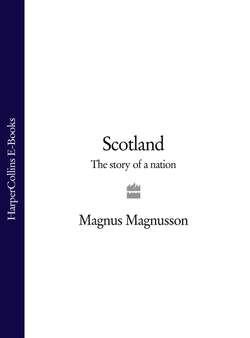Читать книгу Scotland: The Story of a Nation - Magnus Magnusson - Страница 17
Chapter 3 PICTS, SCOTS, BRITONS, ANGLES AND OTHERS
ОглавлениеThese people of the northern parts of Scotland, whom the Romans had not been able to subdue, were not one nation, but divided into two, called the Scots and the Picts; they often fought against each other, but they always joined together against the Romans, and the Britons who had been subdued by them.
TALES OF A GRANDFATHER, CHAPTER I
In the western outskirts of Inverness stands a massive hill crag, now engulfed in trees – Craig Phadrig. The summit of this crag was once the site of a great hill-fort, a mighty bastion of the early Pictish kings.
Not a lot of people know that it is there, or how to find it when they do know. It stands in the Kinmylies district, near Craig Phadrig Hospital; you drive up the steep, dead-end Leachkin Brae, which is not marked as leading to anywhere. Forest Enterprise has provided two woodland walks which meander through the forest at the lower levels of the crag; each has its own car park. To reach the summit of the crag, you use the second (upper) car park and follow the walkway from it. Then you leave its carefully graded surface, take a very deep breath, and embark on a fiercely steep scramble up, and up, and up.
Twenty-five years ago, archaeologists cleared the surface vegetation and revealed two concentric ramparts crowning the summit; these ramparts had been what is called ‘vitrified’ – that is to say, the timber framework inside the walls had been set on fire (deliberately or accidentally) so that the stone and earth of the massive ramparts were fused into a slaggy mass. The ramparts enclosed a flat expanse measuring some eighty metres by forty. When I was chairman of the Ancient Monuments Board for Scotland in the 1980s, we all toiled up to the top to admire the revelation of this great hill-fort, and decided there and then that Something Must Be Done to make this remarkable monument more accessible and comprehensible to the public; it was being used at the time as an obstacle course by trail riders and motorbike scramblers and the old ramparts were being undermined by the roots of invasive trees.
Well, Something Was Not Done – immediately. The whole summit is now overgrown with thistles and other tall plants. The commanding views of both the Beauly Firth to the north-west and the Moray Firth to the north-east are blocked by massive tree-growth. The ramparts are once again smothered by shrubs and undergrowth. Historic Scotland has plans to clear the summit and its ramparts once again, however, and people should soon be able not only to reach the summit with much greater ease but also to understand what is to be seen there.
Craig Phadrig was a major Pictish stronghold in the north of Scotland from the fifth century onwards. Towards the end of the sixth century it was the fastness of one of the most powerful kings named in the Pictish king-lists – King Bridei mac Máelchú, often called by the anglicised name of ‘Brude’. In his monumental A History of the English Church and People (c.731), the Venerable Bede described King Bridei as rex potentissimus, and he seems to have been the over-king of many local kingdoms which comprised the core of the realm of ‘Pictland’, or ‘Pictavia’; this realm extended from around the Firth of Forth and covered the centre and north-east of Scotland as far as Orkney (the name for the sea between Caithness and Orkney is the ‘Pentland’ Firth, which is a Norse word meaning ‘Pictland’). One of his ‘capitals’ may have been on Castle Hill in Inverness; and it is tempting to see Craig Phadrig as the place where St Columba (see below) may have met King Bridei during an expedition up the Great Glen to convert the northern Picts to Christianity in the latter half of the sixth century.
According to Columba’s biographer, Adomnán, King Bridei refused to open the heavy double gates of the ramparts to his missionary visitor. Columba then went up to the gates, made the sign of the cross against them and knocked; the bolts slid back of their own accord and the gates swung open – whereupon King Bridei ‘greatly honoured the holy and venerable man, as was fitting, with the highest esteem’.
